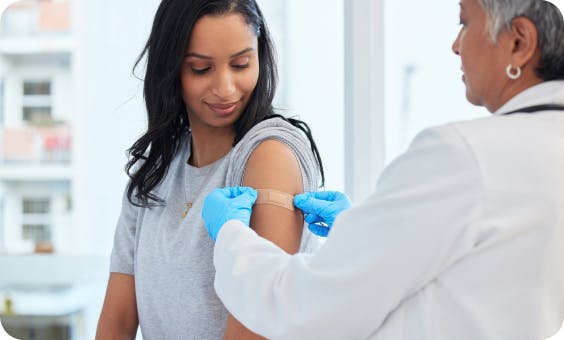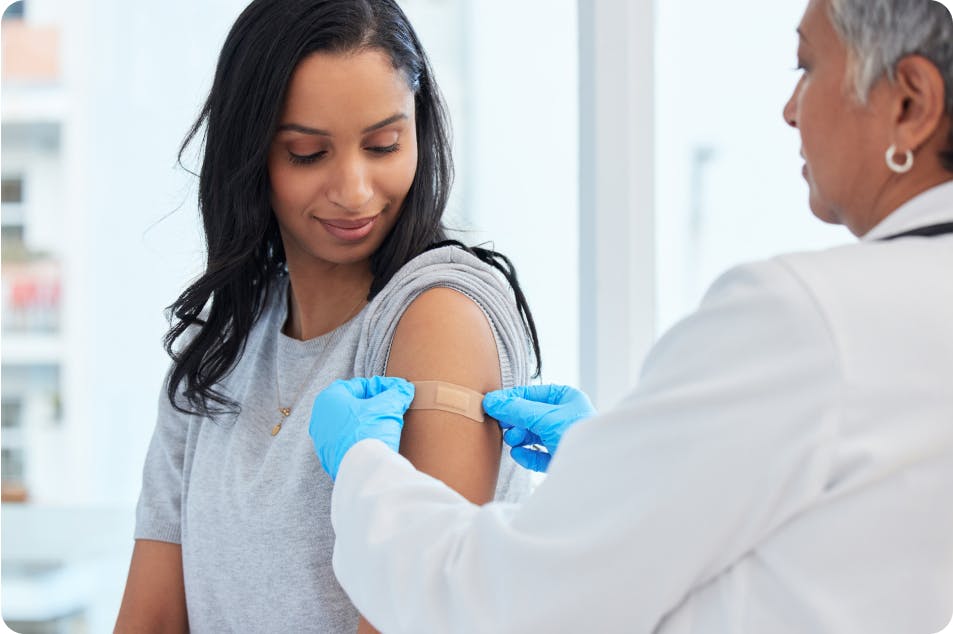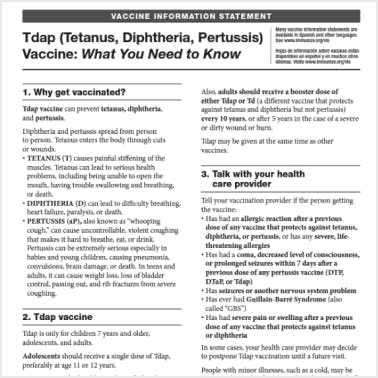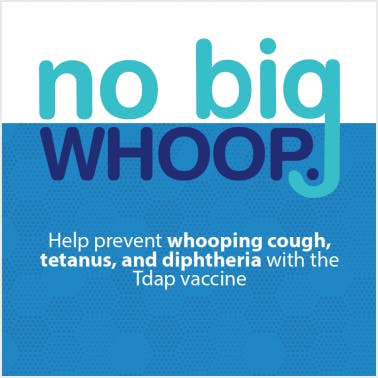Tetanus
Tetanus is an acute, frequently fatal disease caused by bacteria that typically enter the body through a wound.1 Tetanus is characterized by skeletal muscle spasms and rigidity that commonly begins in the jaw and neck, then progresses in a descending pattern.1
Diphtheria
Diphtheria is a disease caused by toxin-producing bacteria that can lead to formation of a pseudomembrane at the site of infection, commonly the pharynx and the tonsils.2 Diphtheria can result in a life-threatening airway blockage, myocarditis, and neuritis.2 It spreads through respiratory droplets from coughing or sneezing or through exposure to infected skin lesions.2
Pertussis
Pertussis is highly contagious and can spread from person to person through coughing or sneezing.3,4 Pertussis can be especially serious in young infants and can lead to death.4 Children, adolescents, and adults with pertussis, especially those who were not previously vaccinated, may experience bursts of numerous and rapid coughs (paroxysms).4,5 Pertussis can cause complications, such as difficulty sleeping, weight loss, urinary incontinence, syncope, pneumonia, and broken ribs.4,5 Persons with pertussis are infectious from symptom onset through the third week after the paroxysms begin.4
Facts About Tetanus, Diphtheria, and Pertussis
In 2022, over 40% of reported pertussis cases occurred in adults 20 years of age and older.6
The clinical course of pertussis progresses in 3 stages: catarrhal, paroxysmal, and convalescent. The characteristic bursts of rapid coughs, or paroxysms, and subsequent inspiratory "whoop", may begin during the paroxysmal stage. The paroxysmal stage typically lasts for 1 to 6 weeks but can continue for up to 10 weeks.4
Exposure to diphtheria is rare in the United States, but is a risk with international travel to some regions.3
Tetanus is fatal in approximately 1 in 10 infected people.1


Centers for Disease Control and Prevention (CDC) Tdap Vaccination Recommendations
- Adolescents 11 to 18 years of age: These persons should receive a single dose of Tdap, preferably at a preventive care visit at age 11 to 12 years. To ensure continued protection against tetanus and diphtheria, 1 booster dose of either tetanus and diphtheria (Td) or Tdap should be administered every 10 years throughout life7,8
- Adults 19 years of age and older: Regardless of the interval since their last tetanus or diphtheria toxoid-containing vaccine, persons ≥19 years of age who have never received a dose of Tdap should receive 1 dose of Tdap. Booster doses of either Td or Tdap should be administered every 10 years throughout life7,8
- Pregnant women should receive 1 dose of Tdap during each pregnancy, irrespective of their history of receiving the vaccine. Tdap should be administered at 27-36 weeks’ gestation, preferably during the earlier part of this period, although it may be administered at any time during pregnancy7,8
- Wound management: A tetanus toxoid-containing vaccine is indicated for wound management when >5 years have passed since the last tetanus toxoid-containing vaccine dose. If a tetanus toxoid-containing vaccine is indicated for persons aged ≥11 years, Tdap is preferred for persons who have not previously received Tdap or whose Tdap history is unknown. If a tetanus toxoid-containing vaccine is indicated for a pregnant woman, Tdap should be used. For nonpregnant persons with documentation of previous Tdap vaccination, either Td or Tdap may be used if a tetanus toxoid-containing vaccine is indicated.7
Complete information on tetanus prophylaxis and the use of tetanus immunoglobulin when indicated for wound management is available here.
Please refer to the CDC Child and Adolescent Immunization Schedule and Adult Immunization Schedule for complete Tdap recommendations.
Tdap Downloadable Resources
References
- Tiwari TSP, Moro PL, Acosta AM. Tetanus. In: Epidemiology and Prevention of Vaccine-Preventable Diseases. 14th ed. Centers for Disease Control and Prevention; 2021. Reviewed April 25, 2024. Accessed August 23, 2024. https://www.cdc.gov/pinkbook/hcp/table-of-contents/chapter-21-tetanus.html
- Acosta AM, Moro PL, Hariri S, Tiwari TSP. Diphtheria. In: Epidemiology and Prevention of Vaccine-Preventable Diseases. 14th ed. Centers for Disease Control and Prevention; 2021. Reviewed April 23, 2024. Accessed August 23, 2024. https://www.cdc.gov/pinkbook/hcp/table-of-contents/chapter-7-diphtheria.html
- Liang JL, Tiwari T, Moro P, et al. Prevention of pertussis, tetanus, and diphtheria with vaccines in the United States: recommendations of the Advisory Committee on Immunization Practices (ACIP). MMWR. 2018;67(2):1-44. doi:10.15585/mmwr.rr6702a1
- Havers FP, Moro PL, Hariri S, Skoff T. Pertussis. In: Epidemiology and Prevention of Vaccine-Preventable Diseases. 14th ed. Centers for Disease Control and Prevention; 2021. Reviewed April 12, 2024. Accessed August 23, 2024. https://www.cdc.gov/pinkbook/hcp/table-of-contents/chapter-16-pertussis.html
- Clinical Features of Pertussis. Centers for Disease Control and Prevention. Reviewed April 2, 2024. Accessed August 23, 2024. https://www.cdc.gov/pertussis/hcp/clinical-signs/index.html
- 2022 Final Pertussis Surveillance Report. Centers for Disease Control and Prevention. May, 2021. Accessed January 30, 2024. https://www.cdc.gov/pertussis/media/pdfs/2024/06/pertuss-surv-report-2022_FINAL-508.pdf
- Havers FP, Moro PL, Hunter P, Hariri S, Bernstein H. Use of tetanus toxoid, reduced diphtheria toxoid, and acellular pertussis vaccines: updated recommendations of the Advisory Committee on Immunization Practices — United States, 2019. MMWR. 2020;69(3):77-83.
- Vaccines and preventable diseases: diphtheria, tetanus, and pertussis vaccine recommendations. Centers for Disease Control and Prevention. Reviewed August 2, 2024. Accessed September 17, 2024. https://www.cdc.gov/vaccines/vpd/dtap-tdap-td/hcp/recommendations.html






